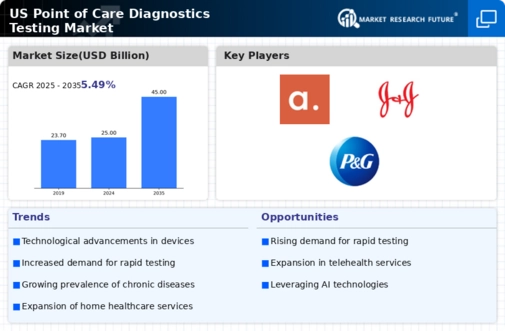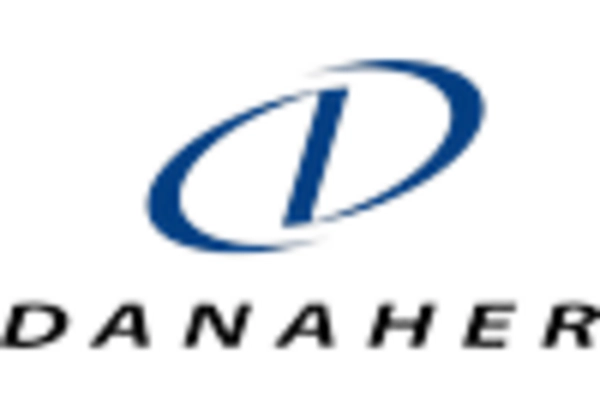Shift Towards Home Healthcare
The shift towards home healthcare is transforming the landscape of the point of-care-diagnostics-testing market. With an increasing number of patients preferring to receive care in the comfort of their homes, there is a growing demand for portable and user-friendly diagnostic devices. This trend is supported by advancements in technology that enable accurate testing outside traditional clinical settings. The US home healthcare market is projected to grow at a CAGR of 8% from 2025 to 2030, indicating a robust demand for point-of-care testing solutions. As patients seek convenience and efficiency, healthcare providers are likely to adopt these technologies to facilitate remote monitoring and management of health conditions. This evolution not only enhances patient satisfaction but also drives the expansion of the point of-care-diagnostics-testing market, as more individuals gain access to timely and effective diagnostic services.
Rising Prevalence of Chronic Diseases
The increasing incidence of chronic diseases in the US is a pivotal driver for the point of-care-diagnostics-testing market. Conditions such as diabetes, cardiovascular diseases, and respiratory disorders necessitate regular monitoring and timely interventions. According to the Centers for Disease Control and Prevention (CDC), chronic diseases account for approximately 7 out of 10 deaths each year, highlighting the urgent need for effective diagnostic solutions. The demand for point-of-care testing is likely to surge as healthcare providers seek to offer immediate results and personalized care. This trend not only enhances patient outcomes but also reduces the burden on healthcare facilities, thereby propelling the growth of the point of-care-diagnostics-testing market. As the population ages and the prevalence of these diseases rises, the market is expected to expand significantly, potentially reaching a valuation of $50 billion by 2027.
Increased Focus on Preventive Healthcare
The growing emphasis on preventive healthcare is a significant driver for the point of-care-diagnostics-testing market. As healthcare systems in the US shift from reactive to proactive approaches, there is a heightened demand for early detection and monitoring of diseases. Preventive measures can lead to better health outcomes and reduced healthcare costs. The US healthcare expenditure on preventive services is expected to rise, with estimates suggesting an increase of 5% annually over the next five years. This trend encourages the adoption of point-of-care testing, as it allows for immediate results and timely interventions. By facilitating early diagnosis, these tests can potentially reduce the incidence of severe health complications, thereby driving the growth of the point of-care-diagnostics-testing market. The integration of these services into routine healthcare practices is likely to become more prevalent, further enhancing market dynamics.
Rising Consumer Awareness and Engagement
The rising consumer awareness regarding health and wellness is a notable driver for the point of-care-diagnostics-testing market. As individuals become more informed about their health, there is a growing demand for accessible and reliable diagnostic solutions. This trend is reflected in the increasing popularity of health apps and wearable devices that facilitate self-monitoring. According to a recent survey, approximately 60% of US consumers express interest in using point-of-care testing for routine health checks. This heightened engagement encourages healthcare providers to incorporate point-of-care diagnostics into their services, thereby enhancing patient access to timely testing. The point-of-care diagnostics testing market is likely to benefit from this trend, as more consumers seek convenient and efficient ways to manage their health. The potential for increased patient participation in their healthcare journey may lead to improved health outcomes and a more proactive approach to health management.
Technological Integration in Healthcare Systems
The integration of advanced technologies into healthcare systems is a crucial driver for the point of-care-diagnostics-testing market. Innovations such as artificial intelligence, machine learning, and telemedicine are reshaping how diagnostic tests are conducted and interpreted. These technologies enhance the accuracy and efficiency of point-of-care testing, enabling healthcare providers to make informed decisions rapidly. The US healthcare technology market is projected to reach $500 billion by 2026, indicating a robust investment in innovative solutions. As healthcare providers increasingly adopt these technologies, the demand for point-of-care diagnostics is likely to grow. This integration not only streamlines workflows but also improves patient engagement and satisfaction, thereby propelling the expansion of the point-of-care diagnostics testing market. The potential for real-time data analysis and remote monitoring further underscores the importance of technological advancements in this sector.

















Leave a Comment